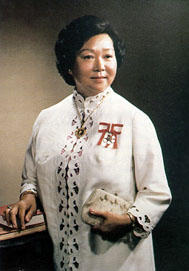 First
Chinese Canadian to Receive Order of Canada
First
Chinese Canadian to Receive Order of Canada
Like the mighty dragon in Chinese mythology, Jean Lumb’s spirit and determination have made her a symbol to be admired. Her father came to Canada from China, 1899, to work as a farm labourer. After saving enough money to send for his wife and their six-year-old son, the family grew 11 more in number. Jean was born, 1919, Nanaimo, British Columbia, at a time when Chinese families in Canada faced discrimination, had no right tovote, attended segregated schools, and were not permitted to become professionals. By the time Jean was 16 years, she, with sister Dorothy, was travelling by train from Vancouver to Toronto to help an older sister and husband in their grocery store. When she married Doyle Lumb, 1939, they were the first Chinese in Toronto married in a church. Establishing their own business, together they worked for 20 years in their grocery store, at the same time raising three sons and three daughters. In 1959, they opened a restaurant, Kwong Chow, in Chinatown which became famous for its Cantonese cuisine. But Jean Lumb had another mission: to end all restrictions on Chinese wanting to immigrate to Canada, especially that part of the legislation that kept Chinese families in Canada separated from family across the seas. A member, 1957, of a Chinese Delegation lobbying Prime Minister John Diefenbaker to pass laws permitting the rejoining of families long separated one from the other, Jean Lumb was happy to see the repeal of such discriminating legislation. Jean also led the fight to save Toronto’s Chinatown and then fought successfully to save Chinatowns in both Vancouver and Calgary. Over the years, Jean became an important link between non-Chinese Canadians and Chinese people, helping to share Chinese thoughts and feelings with government officials. She did the same when volunteering in hospitals, old-age centres, and women’s organizations. Serving as a Citizenship Judge, Jean Lumb’s greatest moment came, 1976, when she received the Order of Canada, the first Chinese-Canadian to be so honoured. [Photo, courtesy Cavouk Portraits via Jean Lumb]
 Quintessential
Ballerina
Quintessential
Ballerina